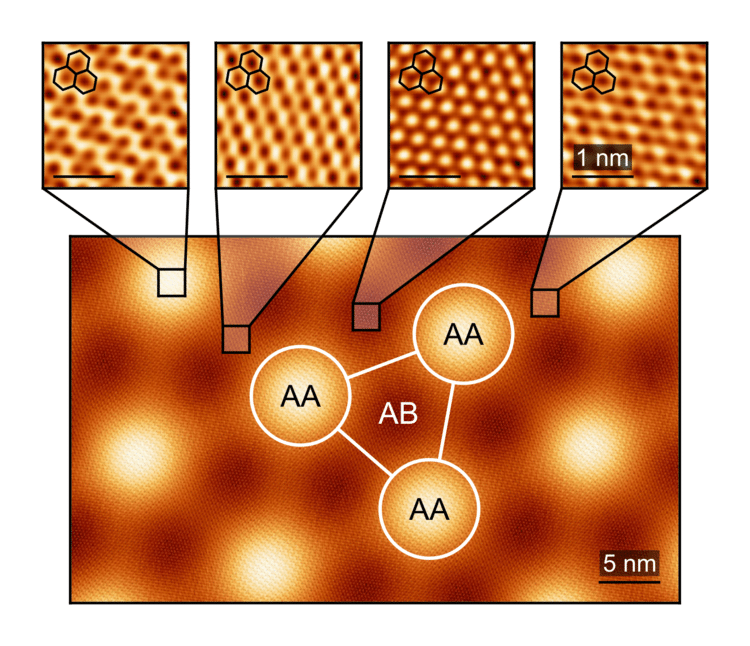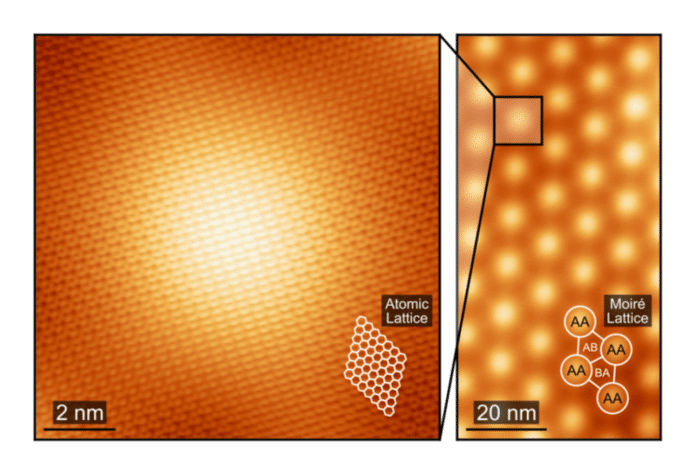In 2018, Pablo Jarillo-Herrero and his team at MIT discovered the amazing properties of twisted bilayer graphene. They observed that the material could be superconducting. This state is essential for numerous day-to-day applications.
Since that discovery, twisted bilayer graphene has demonstrated many novel quantum physical states. All these states are created by complex interactions of electrons.
How and why electrons form insulating states in magic-angle twisted bilayer graphene (MATBG) has been one of the vital unsolved puzzles in the field. A Princeton University-led team of scientists has found a solution to this puzzle.
The team has imaged the microscopic underpinnings responsible for many quantum phases observed in a material known as magic-angle twisted bilayer graphene (MATBG). They, for the first time, were able to capture unprecedentedly precise visualizations of the microscopic behavior of interacting electrons that give rise to the insulating quantum phase of MATBG.
Using novel and innovative theoretical techniques, scientists could determine the material’s behavior.

Researchers stack two sheets of graphene on top of one another, with the top layer slightly tilted, to achieve the necessary quantum effects. This moire pattern produces a moiré pattern; it is called after a typical French textile pattern and resembles it. However, it’s crucial to note that the exact angle at which the top layer of graphene must be positioned is 1.1 degrees. This “magic” angle causes odd, highly correlated interactions between the electrons in the graphene sheets, which is what the quantum effect is known as.
While multiple quantum phases in this material, such as the insulating phase and the zero-resistance superconducting phase, have been demonstrated by physicists, it is still being determined why these phases exist in MATBG. The earlier MATBG experiments provide good examples of the states the system can produce, but they must explain why it has these states.
And the current experiment was built around the “why.”
Kevin Nuckolls, the co-lead author of the paper, who earned his Ph.D. . in 2023 in Princeton’s physics department and is now a postdoctoral fellow at MIT, said, “The general idea of this experiment is that we wanted to ask questions about the origins of these quantum phases-to understand what exactly are the electrons doing on the graphene atomic scale.”
“Being able to probe the material microscopically, and to take images of its correlated states-to fingerprint them, effectively-gives us the ability to discern very distinctly and precisely the microscopic origins of some of these phases. Our experiment also helps guide theorists in the search for phases that were not predicted.”
In this study, scientists used a scanning tunneling microscope (STM) to probe this very minute realm.
The tool uses a process known as “quantum tunneling,” in which electrons are directed between the sample and the microscope’s pointed metallic tip. Instead of using light, the microscope employs this tunneling current to see the atomic-scale world of electrons. Images of the materials are then produced using high-resolution and susceptible measurements of these quantum tunneling events.
However, developing what the researchers refer to as a “pristine” sample was the first stage—and possibly the most important step in the experiment’s success. The twisted bilayer graphene sample couldn’t contain any faults or imperfections on the surface of the carbon atoms.
Ali Yazdani, the Class of 1909 Professor of Physics and Director of the Center for Complex Materials at Princeton University, said, “The technical breakthrough that made this paper happen was our group’s ability to make the samples so pristine in terms of their cleanliness such that these high-resolution images that you see in the paper were possible.”
“You have to make one hundred thousand atoms without a single flaw or disorder.”
The graphene sheets were positioned at the perfect “magic angle,” or 1.1 degrees, in the experiment. Then, scientists placed the STM’s pointed, metallic tip over the graphene sample and slid it over it while measuring the quantum mechanical tunneling current.
With this knowledge, scientists could draw some highly insightful conclusions regarding the quantum phases that the twisted bilayer graphene formed. The quantum insulating phase that emerges when graphene is set to its magic angle has long been a mystery to researchers working in this field, and the researchers used this knowledge to concentrate on and resolve it.
To help understand this from a theoretical viewpoint, the team collaborated with a team from the University of California-Berkeley. Scientists then developed a novel and innovative theoretical framework called “local order parameter” analysis to interpret the STM images and understand what the electrons were doing. They found that strong repulsion between the electrons forms the insulating state.
This theoretical framework also helped scientists to measure the observed wave functions of the electrons.
Scientists noted, “The experiment introduces a new way of analyzing quantum microscopy.”
According to the researchers, the technology—both the theoretical framework and the imagery—can be used in the future to examine and comprehend a variety of other quantum phases in MATBG and, ultimately, to help understand novel and unusual material properties that might be helpful for applications in the development of next-generation quantum technologies.
Journal Reference:
- Nuckolls, K.P., Lee, R.L., Oh, M. et al. Quantum textures of the many-body wavefunctions in magic-angle graphene. Nature 620, 525–532 (2023). DOI: 10.1038/s41586-023-06226-x
